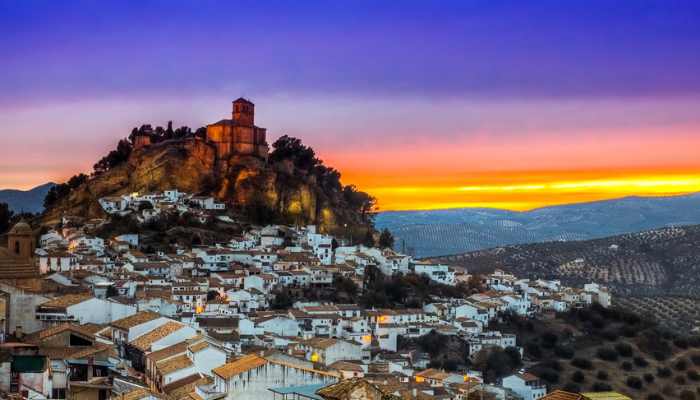Healthy pleasures in rural Andalusia: a journey back 700 years

Seven Moorish villages in southern Spain provide an ideal retreat, offering mountain air, refreshing springs, and ample reasons to celebrate
On our first morning in Atalbéitar, I step into the kitchen to brew some coffee and momentarily question if the effects of last night’s celebration are lingering. Then, I realize it’s not me; it’s the kitchen floor, gently sloped. Carrying the coffee back to bed requires caution due to the uneven steps and small doorways that risk bumping your head. As I lie there, beneath a ceiling crafted from woven chestnut branches and stone slabs, I survey the space and delight in the absence of any right angles.
We are lodged in a Moorish dwelling in this Andalusian hamlet, feeling transported back 700 years to its origins. Having visited Spain extensively over the years while my husband leads wilderness tours, we’ve explored hidden corners and mountain paths from one end of the country to the other. Yet, arriving in Atalbéitar at night, navigating its labyrinthine alleys, ducking under ancient covered passageways with spring water gushing beside us, we both concur: we’ve never encountered a place quite like this. The village seems to have organically emerged from the landscape, rather than being imposed upon it. Its streets are too narrow for cars, village cats wander freely, and the only sound is the occasional bleat of goats on the hillsides. Gazing over the valley on this crisp winter morning, the sun radiates in a clear blue sky, while early almond blossoms paint the rocky hills in pastel pink hues. All is serene and hushed.
Atalbéitar is located within La Tahá, a cluster of seven villages nestled in the Alpujarras region of Andalucía. Positioned on a small southern slope of the Sierra Nevada, it overlooks the deep gorge of the Trevélez River. These villages—Pitres, Atalbéitar, Capilerilla, Mecina, Mecinilla, Fondales, and Ferreirola—were settled by the Nasrid dynasty of Granada, the same dynasty responsible for the Alhambra. Their enduring Moorish ambiance is preserved through their distinct architecture and secluded setting. Access to the valley is via a winding mountain road that traverses Pitres, the primary town, with the other villages accessed by branching roads, ensuring a lack of through traffic.
In Atalbéitar, this is not a concern, as there is no commerce. The village, with a population of 31, lacks a shop or restaurant. However, there is an ad hoc social club/bar operated by village stalwart Jesus, who opens his home on the main square when he feels like it. Nevertheless, the village enjoys a vibrant social life. La Tahá hosts a full calendar of festivals, many tied to Easter and various saints’ days, while others are unique to the region. These include the Mauraca autumn chestnut festival and the summer Santa Cruz fiesta, featuring a traditional “burial of the fox” ceremony with a costume parade ending in the bonfire cremation of a mock fox filled with fireworks.
The village appears to have organically emerged from the land, rather than being artificially placed upon it
In mid-January, we arrive just in time for the first festival of the year, Chisco de San Antón, where each village in La Tahá celebrates with a bonfire in the central plaza and a feast of barbecued pork and local sweet wine. The original purpose of the festivities seems to have faded over time – now it’s all about the celebration. What stands out to us, coming from financially strained England with its struggling local councils, is that the local government provides all the meat, bread, and alcohol for the event.
Before long, the flames dance high, local musicians form a jam band by the fire, and the aroma of roasting meat fills the air. The crowd, small and welcoming, spans various ages and nationalities, a typical scene in La Tahá according to our hosts, Tom and Carmen, a Scottish-Spanish couple. The region is a quiet success story, defying the common narrative of rural Spain’s abandoned villages and declining populations. Over time, the seven villages have attracted an international community of artists, musicians, and writers. Nearby Orgiva, a major town known for its long-standing hippy commune and bohemian vibe, is a mere 45-minute drive from La Tahá, offering its rambling old houses and fertile land as a perfect setting to embrace “la buena vida.”
La Tahá offers a genuine natural detox experience, devoid of costly retreats or burnt-out executives-turned-wellness gurus
In the morning, as I navigate the sloping kitchen floor, I remind myself of our holiday goals: two weeks of healthy living following the indulgences of the festive season, beginning with a brisk walk each day. La Tahá’s villages are linked by a network of trails, and during our stay, we pledge to walk to each one. Our initial excursion leads us along the river gorge to Pitres: it’s a breathtaking, challenging hike marked by moments of awe and a sobering realization of our fitness levels.
The slopes of the Trevelez valley are incredibly steep, weaving through enchanting forests of pine and oak, with citrus orchards in the villages, and wild figs and pomegranates dotting the landscape. The valley’s geology is layered with mica, giving the terrain a silvery shimmer in the sunlight. Walking through this lush, green land, it’s hard to fathom that much of Spain is suffering from a severe drought. Streams cascade down the mountainside, and natural springs emerge from the rock. Deep in the forest, we reach the renowned Fuente la Gaseosa spring, where a high concentration of iron carbonates in the rock creates a natural effervescent water source, bubbling straight from the ground.
We begin our hikes with the toughest uphill climbs, but eventually descend to the valley floor, guided by the sound of the roaring Trevelez long before it comes into view. Our perseverance is met with a thrilling scramble through the dense vegetation to a refreshing plunge into a natural pool beneath a Roman bridge.
The clear light, plentiful water, and fresh mountain air work wonders for any ailment. In our hyper-connected lives in Western Europe, it’s astonishing that such enchanting, unspoiled places still exist. The villages themselves are charming in their simplicity, with only a few modest, traditional hotels and cafés offering good coffee and little else. Pitres hosts a weekly market, and vans selling bread and fish make their rounds through the villages.
La Tahá offers a genuinely natural detox, without the usual wellness jargon. There are no pricey retreats or former executives turned wellness experts urging you to live your best life. Instead, you’ll find a host of territorial cats, an elderly man in his pajamas cheerfully grunting “Buenas” from his balcony every morning, and all the riches of the earth—everything you need for a fulfilling life.


